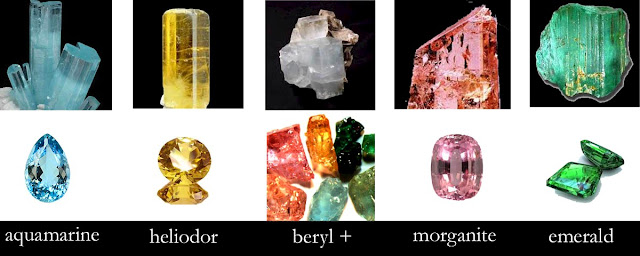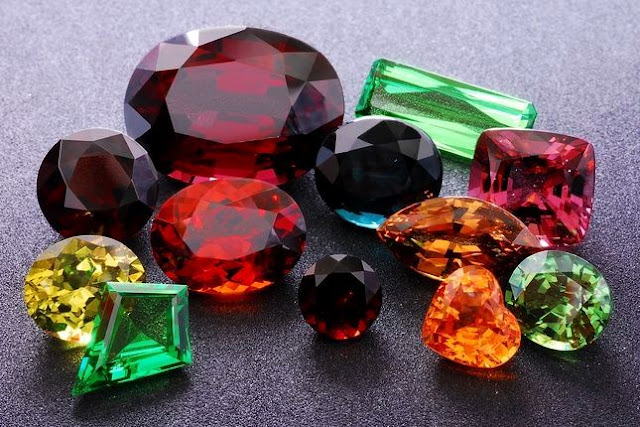Color of Minerals
one of the most important physical properties of minerals, reflecting the nature of the interaction of the electromagnetic radiation of the visible region with the electrons of the atoms, molecules, and ions of the crystals and with the electron system of the crystal as a whole. In mineralogy, color is one of the primary diagnostic properties of natural compounds, of great importance in geological prospecting for the identification of minerals.
The color of gems and semiprecious stones is one of their main qualitative (gem) characteristics. A distinction is made between the color of minerals in individual crystals and lumps of ore, the color of minerals in transparent thin sections (under the microscope), the color of minerals in polished sections (in reflected light), and the color of a mineral?s streak (the color of the fine powder of the mineral).
A comparative evaluation is usually used in describing the color of minerals; the mineral?s color is compared to the color of some commonly known object or substance (indigo blue, apple green, lemon yellow, and blood red) or to mineral ?color standards,? such as vermilion red and emerald green.
The colors of metals or alloys are used as standards for describing the color of ore minerals: tin white (arsenopyrite), steel gray (molybdenite), brass yellow (chalcopyrite), and copper red (native copper). Methods are being developed for an objective evaluation of the color of minerals, especially of gems, using standard colorimetric characteristics. Many minerals have the property of exhibiting different colors in different crystallographic directions, especially in polarized light, or changing their color with the color temperature of the radiative source illuminating them.
Three main groups of minerals are identified on the basis of the property of color: idiochromatic, allochromatic, and pseudochro-matic.
- Idiochromatic minerals are “self colored” due to their composition. The color is a constant and predictable component of the mineral. Examples are blue Azurite, red Cinnabar, and green Malachite.
- Allochromatic minerals are “other colored” due to trace impurities in their composition or defects in their structure. In this case, the color is a variable and unpredictable property of the mineral. Examples are the blue in Amazonite (orthoclase), yellow in Heliodor (spodumene) and the rose in rose quartz.
- Pseudochromatic minerals are “false colored” due to tricks in light diffraction. In these cases, color is variable but a unique property of the mineral. Examples are the colors produced by precious opal and the shiller reflections of labradorite.
The color of metallic and covalent compounds, such as native metals and sulfides and their analogs, is due to interzonal optical transfers of electrons and the related maximums of reflection (for example, the metallic colors of pyrite and gold) or is due to the fundamental absorption band (cinnabar, orpiment, cuprite).
In another type of idiochromatic mineral, the color is due to electron transfers between different ions, namely, charge transfers. This includes the transfer between a metal ion and ligands and the transfer between differently charged metal ions. Examples are minerals of trivalent iron (the charge transfer O2 ? Fe3+); the chromates, vanadates, and molybdates, such as crocoite, vanadinite, and wulfenite (the transfer O2 ? Cr6+, V5+, Mo6+); and minerals that at the same time contain the differently charged ions Fe2+ and Fe3+, such as cordierite, vivianite, and aquamarine.
 |
| credit: Carina Rossner |
- Beryl and Fe++ = Aquamarine (blue)
- Beryl and Fe+++ = Heliodor (yellow)
- Beryl and Mn++ = Morganite (pink)
- Beryl and Cr+++ = Emerald (green)
Color associated with ions of the transition metals?Ti, V, Cr, Mn, Fe, Co, Ni, and Cu?is typical of emerald, ruby, rubellite, rhodonite, chrysolite, and malachite. The lanthanides and actinides are chromophores of minerals of the rare-earth elements and uranyl. Their color is due to the transfers of electrons between the d- and f-levels of the chromophore ions.
Color caused by radioactivity is related to the formation of electron-hole color centers by the action of natural ionizing radiation, for example, the dark blue and purple color of halite and fluorite and the yellow and smoky color of quartz and calcite.
In allochromatic minerals the color is due to the presence of impurities, usually inclusions of colored minerals but occasionally bubbles of liquids or gases. For example, the reddish orange color of carnelian is caused by inclusions of iron hydroxides, while the green color of prase, a variety of quartz, is linked to inclusions of spicules of actinolite or chlorite.
In pseudochromatic minerals the color is due to the diffraction and interference of light, as well as to the dispersion, refraction, and total internal reflection of incident white light. These phenomena are related to the structural features of mineral formations (regular alternation of phases of different composition in iridescent labradorites and peristerites and in sunstone [aventurine feldspar] and moonstone; the globular structure of opals) or to the structure of the surface layer of crystals (various types of tarnish, such as the iridiscent film on bornite, chalcopyrite, pyrite, and covellite).
The study of the color of minerals provides information about the crystallochemical and genetic characteristics of minerals and is useful in the synthesis of high-quality analogs of natural gems.
REFERENCES
Marfunin, A. S. Vvedenie v fiziku mineralov. Moscow, 1974.
Platonov, A. N. Priroda okraski mineralov. Kiev, 1976.
Web Minerals
Encyclopedia
